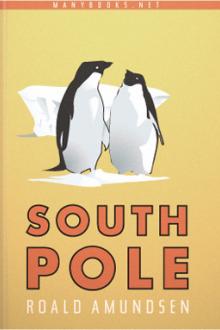The North Pole by Robert E. Peary (room on the broom read aloud .TXT) 📕

- Author: Robert E. Peary
- Performer: -
Book online «The North Pole by Robert E. Peary (room on the broom read aloud .TXT) 📕». Author Robert E. Peary
The next day we completed the circuit of the western shore of the Inlet, then started on a bee line for Sail Harbor, making this a forced march. At Sail Harbor we found a note from Bartlett, showing that he had passed there the previous day on his way back from Cape Columbia to the ship.
There we camped again; and in the morning, while the men were breaking camp and lashing up the sledges, I started with the very first rays of the morning light across the peninsula towards James Ross Bay. As I crested the divide, I saw—down on the shore of the Bay—a group of dark spots which were clearly recognized as a camp; and a little later I sang out to the party, which comprised the divisions of Bartlett, Goodsell, and Borup.
By the time the sleepy-eyed, stiff figures of the three men—who, as I soon learned, had been asleep only an hour or so—emerged from the tents, my sledges and Eskimos were close at my heels. I can see now the bulging eyes of the men, and particularly of young Borup, when they saw the sledge loads of shaggy skins. On the top of the leading sledge was the magnificent snowy pelt of the polar bear, with the head forward; behind this was the deerskin with its wide-antlered head, and more musk-ox heads than they had had time to count.
"Oh, gee!" exclaimed Borup, when his open-mouthed astonishment would permit of articulation.
I had no time for visiting, as I wanted to reach the ship on that march; and after a few words left the men to finish their interrupted sleep. It was long after dark when we reached the Roosevelt. We had been absent seven sleeps, had traveled over two hundred miles, had accomplished the exploration of Clements Markham Inlet, had made a rough map of it, and incidentally had obtained magnificent specimens of the three great animals of the arctic regions, thus adding a few thousand pounds of fresh meat to our winter supply. So, with a feeling of entire satisfaction, I had a hot bath in my cabin bathroom on the Roosevelt, and then turned in to my bunk for a long and refreshing sleep.
Throughout the month of October the work of transporting supplies and of hunting went on. The captain made two round trips from the ship to Cape Columbia; but he was working backward and forward all the time along the route. In the course of this work he obtained four musk-oxen.
(From Photographs taken on the Return Voyage)
MacMillan recovered from his attack of grip, and on the 14th of October was sent with two sledges, two Eskimos, and twenty dogs to make a survey of Clements Markham Inlet and obtain musk-oxen and deer. He bagged five of the former. The last of the month the doctor also had an attack of grip, which kept him in bed for a week or two. Many small parties were sent out on short hunting trips and there was hardly a day during the fall when the men were all on the ship at one time.
While, from the time of our arrival at Cape Sheridan early in September to the date of our departure from land for the Pole on March 1, every member of the expedition was almost constantly engaged in work that had for its object the completing of preparations for the final sledge journey in the spring, no small part of this work was educational in purpose and result. That is to say, it was intended to inure the "tenderfeet" of the party to the hardships of long journeys over rough going and through low temperatures, snow and wind. It taught them how to take care of themselves under difficult conditions, how to defend themselves against the ever-present peril of frost-bite, how to get the greatest comfort and protection from their fur clothing, how to handle their valuable dogs and how to manage their Eskimo helpers so as to get the best results from their efforts.
An entry in Dr. Goodsell's journal is so typical of the chief troubles of any arctic sledging journey that it is worth repeating here.
"Have been utilizing the time," wrote Dr. Goodsell, "in trying to dry out stockings and boots. It is extremely difficult to dry out stockings because of the cold and the necessity of economizing fuel. The general procedure is to discard footgear when it is nearly saturated with moisture. As long as the footgear is dry there is little danger of frosting the feet, if ordinary precautions are taken. With wet footgear one is in constant danger of freezing the feet. The oil-stove with the three-inch burner is barely sufficient to dry the gloves, of which two pairs are worn, an outer pair of bearskin, and an inner pair of deerskin." Another journal entry deals with a different kind of peril:
"Toxingwa and Weesockasee were overcome by the lack of oxygen and the fumes of alcohol while MacMillan was preparing tea. Weesockasee fell back as though asleep. Toxingwa was twisting around, as though to get his arm free from one sleeve of his jacket. He too, finally fell back. MacMillan surmised the cause and kicked the door to one side. In about fifteen or twenty minutes they came around all right. The Commander on another of his expeditions nearly had a similar experience when he saw his Eskimos acting strangely, and quickly kicked out the side of the igloo."
Still another peril that is omnipresent in sledge journeys over a polar sea is that of falling through thin ice and getting thoroughly wet. Perhaps it is not necessary to enlarge upon the gravity of this danger, since it was precisely such an accident that cost Professor Marvin his life. Even if the victim of such an accident should be able to drag himself out of the water, he would in all probability speedily freeze to death. Death by freezing comes speedily to a water-soaked man when temperatures are ranging anywhere from 20 to 60 degrees below zero.
"Just finished changing my boots for a dry pair," writes the doctor. "Crossing a lead covered with thin ice and fissured in the center, my left leg went in to the knee. Fortunately my right foot was forward on firm ice and I threw myself ahead, going down on my left knee on the edge of firm ice and drawing my leg out of the water. At another lead the ice gave way as I sprang from its surface. My right foot dipped into the water to the ankle. I do not understand why I did not go down bodily into the water. Had I gone in to my waist there would have been a serious result, for the sledges were some distance away and the temperature was 47° below zero. In the absence of an igloo and a change of clothes near at hand, a ducking in this temperature would certainly have a serious termination."
Trying conditions these—yet the thing had its irresistible fascination, and now and then came reflective moments like the one on February 25, when the doctor, encamped on the way from the Roosevelt to Cape Columbia, wrote as follows:
"When I was nearing Point Good, insensibly I paused time and again to view the scene. I could see Cape Hecla to the rear and the Parry Peninsula. In advance the twin peaks of Cape Columbia beckoned us on to the second point of departure in the Commander's northward march. To the north as we progressed, beyond the comparatively smooth glacial fringe loomed the floes and pinnacles of rough ice which will try us all to the utmost for weeks to come. To the south the circumference of the horizon was bounded by the sharp, jagged, serrated mountain ranges, mostly parallel to the coast. Every day we have a glorious dawn lasting for hours. A golden gleam is radiated from parallel ranges of serrated mountains. Individual peaks reflect the light of the sun, which will illuminate them with its direct rays in a few days. There is a cornea of golden glow, crimson and yellow, with strata of darker clouds floating parallel to the coast ranges—Turner effects for hours each day and for days in succession, the effect increasing from day to day. I am writing under difficulties, Inighito (an Eskimo) holding the candle. My hands are so cold that I can scarcely guide my pencil, as I recline on the bed platform of the igloo."
But all this anticipates. On the 12th of October the sun had bidden us good-by for the year, and the rapidly darkening twilight increased the difficulties of the field work. Our photographs grew daily less satisfactory. We had not been able to take snapshots since about the middle of September; for, when the sun is near the horizon, though the light is apparently as brilliant as in summer, it seems to have no actinic power. Our first time-exposures were five seconds; our last, on the 28th of October, were ninety minutes. The temperature also was gradually getting lower, and on the 29th of October it was 26° below zero.
The fall work ended with the return of Bartlett and his party from Cape Columbia, on November 5th, the other men having all returned before. By that time the light had disappeared, and it would be necessary to wait for the recurring moons of the long winter night before we could do any more work.
We had gone up there in the arctic noon, had worked and hunted through the arctic twilight, and now the night was upon us—the long arctic night which seems like the valley of the shadow of death. With nearly all the supplies for the spring sledge journey already at Cape Columbia, with a good store of fresh meat for the winter, and our party all in good health, we entered the Great Dark with fairly contented hearts. Our ship was apparently safe; we were well housed and well fed; and if sometimes the terrible melancholy of the dark clutched for a moment at the hearts of the men, they bravely kept the secret from each other and from me.
CHAPTER XVIII THE LONG NIGHTIt may well be doubted if it is possible for a person who has never experienced four months of constant darkness to imagine what it is. Every school boy learns that at the two ends of the earth the year is composed of one day and one night of equal length, and the intervening periods of twilight; but the mere recital of that fact makes no real impression on his consciousness. Only he who has risen and gone to bed by lamplight, and risen and gone to bed again by lamplight, day after day, week after week, month after month, can know how beautiful is the sunlight.
During the long arctic night we count the days till the light shall return to us, sometimes, toward the end of the dark period, checking off the days on the calendar—thirty-one days, thirty days, twenty-nine days, and so on, till we shall see the sun again. He who would understand the old sun worshipers should spend a winter in the Arctic.
Showing the Ice Pressure Close to the Ship
Imagine us in





Comments (0)